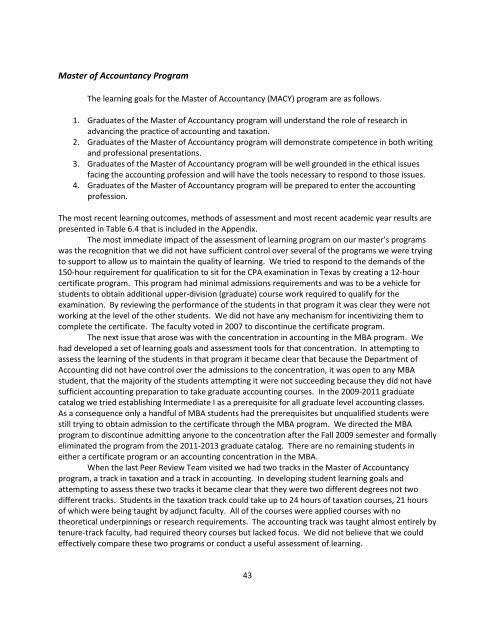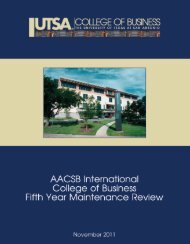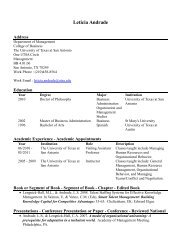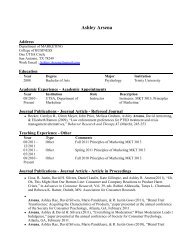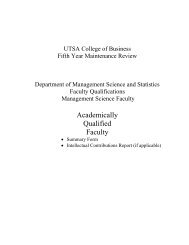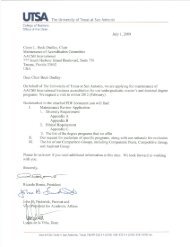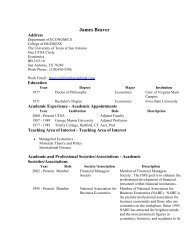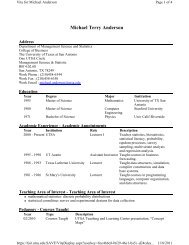Fifth Year Maintenance Report - AACSB - The University of Texas at ...
Fifth Year Maintenance Report - AACSB - The University of Texas at ...
Fifth Year Maintenance Report - AACSB - The University of Texas at ...
- No tags were found...
You also want an ePaper? Increase the reach of your titles
YUMPU automatically turns print PDFs into web optimized ePapers that Google loves.
Master <strong>of</strong> Accountancy Program<strong>The</strong> learning goals for the Master <strong>of</strong> Accountancy (MACY) program are as follows.1. Gradu<strong>at</strong>es <strong>of</strong> the Master <strong>of</strong> Accountancy program will understand the role <strong>of</strong> research inadvancing the practice <strong>of</strong> accounting and tax<strong>at</strong>ion.2. Gradu<strong>at</strong>es <strong>of</strong> the Master <strong>of</strong> Accountancy program will demonstr<strong>at</strong>e competence in both writingand pr<strong>of</strong>essional present<strong>at</strong>ions.3. Gradu<strong>at</strong>es <strong>of</strong> the Master <strong>of</strong> Accountancy program will be well grounded in the ethical issuesfacing the accounting pr<strong>of</strong>ession and will have the tools necessary to respond to those issues.4. Gradu<strong>at</strong>es <strong>of</strong> the Master <strong>of</strong> Accountancy program will be prepared to enter the accountingpr<strong>of</strong>ession.<strong>The</strong> most recent learning outcomes, methods <strong>of</strong> assessment and most recent academic year results arepresented in Table 6.4 th<strong>at</strong> is included in the Appendix.<strong>The</strong> most immedi<strong>at</strong>e impact <strong>of</strong> the assessment <strong>of</strong> learning program on our master’s programswas the recognition th<strong>at</strong> we did not have sufficient control over several <strong>of</strong> the programs we were tryingto support to allow us to maintain the quality <strong>of</strong> learning. We tried to respond to the demands <strong>of</strong> the150-hour requirement for qualific<strong>at</strong>ion to sit for the CPA examin<strong>at</strong>ion in <strong>Texas</strong> by cre<strong>at</strong>ing a 12-hourcertific<strong>at</strong>e program. This program had minimal admissions requirements and was to be a vehicle forstudents to obtain additional upper-division (gradu<strong>at</strong>e) course work required to qualify for theexamin<strong>at</strong>ion. By reviewing the performance <strong>of</strong> the students in th<strong>at</strong> program it was clear they were notworking <strong>at</strong> the level <strong>of</strong> the other students. We did not have any mechanism for incentivizing them tocomplete the certific<strong>at</strong>e. <strong>The</strong> faculty voted in 2007 to discontinue the certific<strong>at</strong>e program.<strong>The</strong> next issue th<strong>at</strong> arose was with the concentr<strong>at</strong>ion in accounting in the MBA program. Wehad developed a set <strong>of</strong> learning goals and assessment tools for th<strong>at</strong> concentr<strong>at</strong>ion. In <strong>at</strong>tempting toassess the learning <strong>of</strong> the students in th<strong>at</strong> program it became clear th<strong>at</strong> because the Department <strong>of</strong>Accounting did not have control over the admissions to the concentr<strong>at</strong>ion, it was open to any MBAstudent, th<strong>at</strong> the majority <strong>of</strong> the students <strong>at</strong>tempting it were not succeeding because they did not havesufficient accounting prepar<strong>at</strong>ion to take gradu<strong>at</strong>e accounting courses. In the 2009-2011 gradu<strong>at</strong>ec<strong>at</strong>alog we tried establishing Intermedi<strong>at</strong>e I as a prerequisite for all gradu<strong>at</strong>e level accounting classes.As a consequence only a handful <strong>of</strong> MBA students had the prerequisites but unqualified students werestill trying to obtain admission to the certific<strong>at</strong>e through the MBA program. We directed the MBAprogram to discontinue admitting anyone to the concentr<strong>at</strong>ion after the Fall 2009 semester and formallyelimin<strong>at</strong>ed the program from the 2011-2013 gradu<strong>at</strong>e c<strong>at</strong>alog. <strong>The</strong>re are no remaining students ineither a certific<strong>at</strong>e program or an accounting concentr<strong>at</strong>ion in the MBA.When the last Peer Review Team visited we had two tracks in the Master <strong>of</strong> Accountancyprogram, a track in tax<strong>at</strong>ion and a track in accounting. In developing student learning goals and<strong>at</strong>tempting to assess these two tracks it became clear th<strong>at</strong> they were two different degrees not twodifferent tracks. Students in the tax<strong>at</strong>ion track could take up to 24 hours <strong>of</strong> tax<strong>at</strong>ion courses, 21 hours<strong>of</strong> which were being taught by adjunct faculty. All <strong>of</strong> the courses were applied courses with notheoretical underpinnings or research requirements. <strong>The</strong> accounting track was taught almost entirely bytenure-track faculty, had required theory courses but lacked focus. We did not believe th<strong>at</strong> we couldeffectively compare these two programs or conduct a useful assessment <strong>of</strong> learning.43


